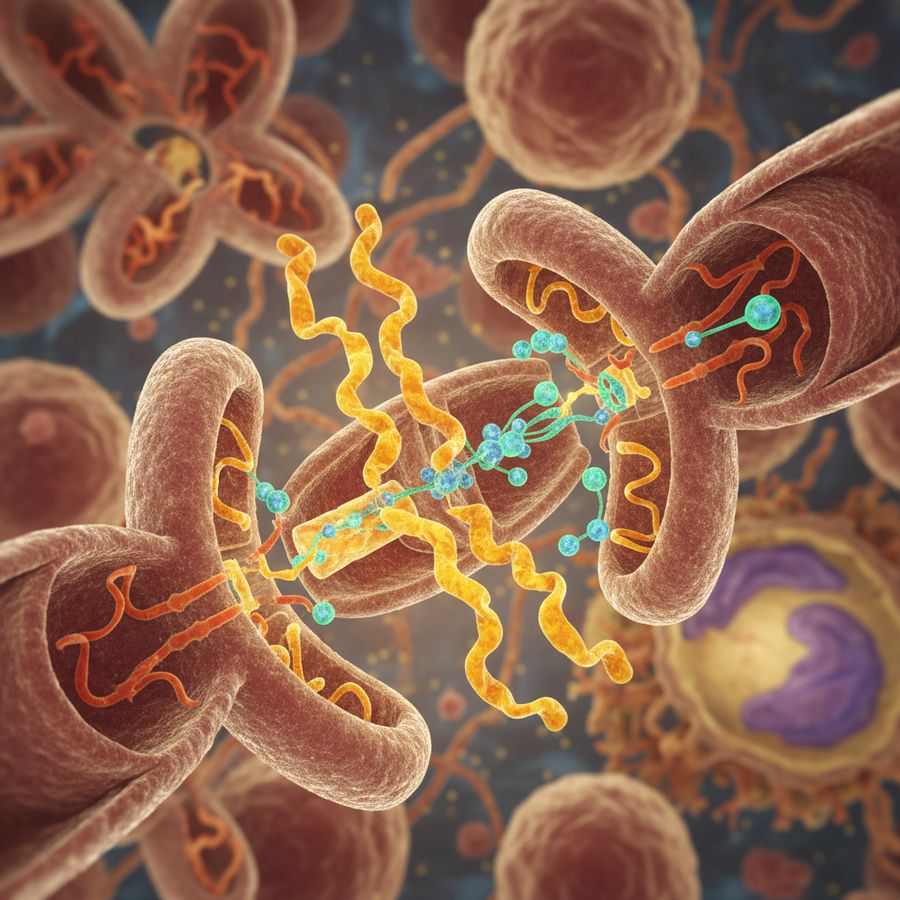Overview
Mitochondria are often described as the “powerhouses” of our cells, and this description is quite fitting given their crucial role in energy production and fat burning. These microscopic organelles are found within nearly every cell of the human body and are responsible for converting nutrients from the food we consume into usable energy. This energy fuels all bodily functions, from muscle movement to brain activity.
Understanding how mitochondria influence metabolism and energy levels is essential for grasping their impact on overall health and weight management. When mitochondria operate efficiently, they not only help the body generate sufficient energy but also optimize the process of burning stored fat. Conversely, impaired mitochondrial function can lead to reduced energy levels, slower metabolism, and accumulation of excess fat.
Recent scientific research highlights the connection between mitochondrial density and metabolic health. Studies have shown that people with higher mitochondrial levels tend to have leaner body composition and improved metabolic performance. This is because mitochondria play a pivotal role in oxidizing fatty acids, thereby directly influencing how effectively fat is burned for energy.
“Mitochondria burn fat and fuel every part of our body to keep it running smoothly. So the more mitochondria you have, the more fat you burn.”
In this article, we will explore the intricate relationship between mitochondrial function and fat metabolism, delve into how energy production occurs at the cellular level, recognize signs of low mitochondrial activity, and discuss practical ways to enhance mitochondrial energy for improved weight control and vitality.

Mitochondrial function in fat metabolism
The primary role of mitochondria in the body is to generate energy through a process called oxidative phosphorylation. This process utilizes nutrients, particularly fats and carbohydrates, to create adenosine triphosphate (ATP), the energy currency of the cell. Fat metabolism is a key aspect of this, where mitochondria convert fatty acids into energy.
Fatty acids stored in adipose tissue are broken down through beta-oxidation inside the mitochondria. This breakdown produces acetyl-CoA, which enters the citric acid cycle (Krebs cycle) to generate NADH and FADH2. These molecules are crucial for the electron transport chain, where the majority of ATP is produced. Efficient mitochondrial function ensures smooth fat oxidation, preventing fat accumulation and supporting a healthy metabolism.
Impaired mitochondrial function can disrupt this process, leading to decreased fat burning and increased fat storage. For example, research shows that individuals with obesity often exhibit reduced mitochondrial biogenesis and activity in their adipose tissue, which contributes to metabolic dysfunction and weight gain.
Furthermore, mitochondria are involved in thermogenesis, a process that generates heat by burning calories, notably in brown adipose tissue. This contributes to energy expenditure and weight regulation. Enhancing mitochondrial activity can stimulate this fat-burning thermogenic process, making it an attractive target for weight management interventions.
- Breakdown of fatty acids via beta-oxidation inside mitochondria
- Conversion of fat into acetyl-CoA for ATP generation
- Role in thermogenesis and energy expenditure
- Relationship between mitochondrial dysfunction and fat accumulation
Overall, the ability of mitochondria to efficiently process and burn fat is central to maintaining a balanced metabolism and healthy body weight. Supporting mitochondrial health can therefore be a strategic approach to enhance fat burning and metabolic performance.

Energy production explained
Energy production within mitochondria is a complex but elegantly coordinated biochemical process. At its core, mitochondria convert the chemical energy stored in macronutrients—carbohydrates, fats, and proteins—into ATP, which powers cellular activities. This conversion occurs mainly through three interconnected stages: glycolysis, the citric acid cycle, and the electron transport chain.
Glycolysis takes place in the cytoplasm, where glucose is broken down into pyruvate. Pyruvate then enters mitochondria and is transformed into acetyl-CoA, which feeds into the citric acid cycle. Within this cycle, high-energy electrons are extracted and transferred to carrier molecules NADH and FADH2.
The electron transport chain, embedded in the inner mitochondrial membrane, utilizes these electrons to pump protons and generate a proton gradient. This gradient drives ATP synthase to produce ATP. This entire process is known as oxidative phosphorylation. Because it requires oxygen, it is a highly efficient way to produce energy compared to anaerobic pathways.
“ATP produced by mitochondria is the fundamental energy source that drives all biological processes—from muscle contraction to brain function.”
Importantly, fats provide more ATP per molecule than carbohydrates, making them a dense energy source. Mitochondria are uniquely equipped to metabolize fatty acids via beta-oxidation, feeding the citric acid cycle and maximizing ATP yield. This is why mitochondrial function is closely linked to the body’s ability to burn fat effectively.
Optimal mitochondrial function not only supports sustained energy but also reduces the production of harmful reactive oxygen species (ROS), which can damage cells if not properly managed. Supporting mitochondrial health through nutrition, exercise, and lifestyle choices helps maintain efficient energy production and overall metabolic balance.
Signs of low mitochondrial activity
Low mitochondrial activity can manifest in various ways, often impacting overall energy levels, metabolism, and health. Since mitochondria are responsible for generating the majority of cellular energy, their reduced function can lead to systemic fatigue and impaired physiological processes.
Common signs of diminished mitochondrial function include:
- Chronic fatigue: Persistent low energy and exhaustion even after rest.
- Weight gain or difficulty losing weight: Slowed metabolism and reduced fat burning capacity.
- Muscle weakness or cramps: Insufficient ATP production affects muscle performance.
- Cognitive difficulties: Brain fog, poor concentration, or memory issues due to inadequate energy supply to neurons.
- Increased susceptibility to illness: Compromised immune responses linked to mitochondrial inefficiency.
These symptoms may arise from mitochondrial dysfunction caused by aging, poor diet, chronic stress, environmental toxins, or underlying medical conditions. Notably, studies have linked lower mitochondrial DNA copy numbers with higher visceral fat accumulation and metabolic diseases.
Recognizing these signs early can encourage proactive measures to support mitochondrial function and improve metabolic health. Consulting with healthcare professionals is advisable if symptoms persist or worsen.
Ways to boost mitochondrial energy
Enhancing mitochondrial function is a promising strategy to improve energy production, accelerate fat burning, and support weight management. Several lifestyle and nutritional interventions are scientifically validated to promote mitochondrial biogenesis and efficiency.
Here are effective ways to boost mitochondrial energy:
- Regular physical activity: Aerobic exercises like walking, cycling, and swimming stimulate mitochondrial biogenesis and improve their function.
- Balanced nutrition: Consuming antioxidants, healthy fats, and essential nutrients supports mitochondrial health. Foods rich in polyphenols and flavonoids (e.g., berries, green tea) enhance mitochondrial dynamics.
- Supplementation: Certain natural compounds like Rhodiola, Maqui Berry, Astaxanthin, Amla, and Theobroma Cacao have been found to promote mitochondrial function and fat oxidation.
- Stress management: Chronic stress impairs mitochondrial activity. Mindfulness, meditation, and adequate sleep help preserve mitochondrial integrity.
- Intermittent fasting: This eating pattern can induce mitochondrial biogenesis and improve metabolic flexibility.
“Supporting mitochondria with targeted nutrients and lifestyle habits can unlock your metabolic power and enhance fat burning.”
Products like Mitolyn are formulated with a proprietary blend of exotic nutrients designed to support healthy mitochondria levels, thereby boosting metabolism and energy. Incorporating these approaches holistically can lead to better metabolic outcomes and overall well-being.
Impact on weight management
Mitochondria’s role in fat burning and energy production directly influences the body’s ability to manage weight effectively. Efficient mitochondrial function promotes the oxidation of fatty acids, thereby reducing fat stores and supporting a leaner body composition.
When mitochondria are functioning optimally, they increase the basal metabolic rate, meaning the body burns more calories even at rest. This enhanced metabolic capacity helps prevent excess fat accumulation and facilitates weight loss when combined with proper nutrition and exercise.
Conversely, mitochondrial dysfunction is often observed in obesity and metabolic disorders. Reduced mitochondrial content and activity impair fat oxidation, leading to fat buildup and metabolic slowdown. This creates a vicious cycle where excess fat further hampers mitochondrial health.
Interventions that improve mitochondrial function can break this cycle by:
- Increasing energy expenditure
- Enhancing fat oxidation
- Improving metabolic flexibility
- Supporting hormonal balance related to appetite and fat storage
Optimizing mitochondrial health is therefore a foundational aspect of sustainable weight management strategies, enabling the body to efficiently convert stored fat into usable energy and maintain vitality.
Conclusion
The mitochondria are indispensable cellular components that power the body’s energy production and fat metabolism. Their efficient function is key to maintaining a healthy metabolism, sustaining energy levels, and effectively managing weight.
Understanding the science behind mitochondrial activity sheds light on why some individuals struggle with low energy and stubborn fat despite diet and exercise. Supporting mitochondrial health through evidence-based lifestyle choices, nutrition, and targeted supplementation can unlock metabolic potential and promote long-term wellness.
“Enhancing mitochondrial function not only fuels your body with energy but also accelerates fat burning, paving the way to improved health and vitality.”
By prioritizing mitochondrial support, you can take control of your metabolism, improve your energy levels, and achieve your weight management goals more effectively.
Leave a Reply